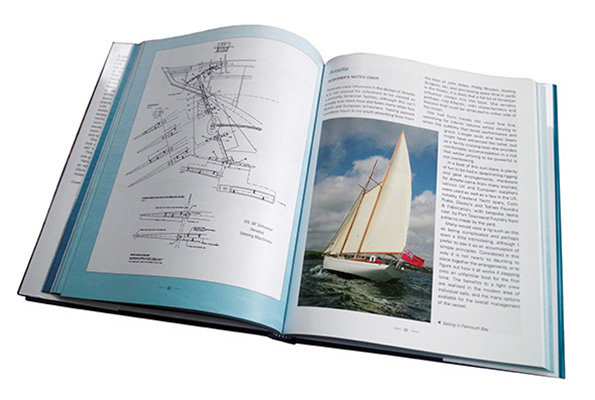1
 Ed Burnett design book out now
Ed Burnett design book out now
When the yacht designer Ed Burnett died in 2015, the world lost one of its best proponents of traditional naval architecture. In fact, within a few years, Ed Dubois, Ed Burnett and our own Theo Rye all died young, leaving a huge hole in this field of expertise. Many would say that Ed Burnett’s designs were the best in the world for what we might call “contemporary traditional” design, a body of work far closer to the yachts and workboats of yesteryear than the more modern designs espoused by the ‘spirit of tradition’ world. We are talking real wooden boats here, sometimes in carvel, sometimes strip-plank or cold mould, usually to traditional form, including in the keel. There are very few naval architects working in this area today – Paul Gartside springs to mind – which makes Burnett’s body of work very valuable.
The new book, with a foreword by Nigel Irens, his early mentor, will be of great use. It has been written by his family, and includes many of his built designs as well as some of his unbuilt ones. It even includes Ed’s first designs, drawn at aged seven and eight, on what looks like school squared paper. These leave you with no doubt as to how extraordinarily talented Ed Burnett was. It’s unusually well-produced for a self-published work, properly laid out, with great photos, informative text and original drawings. As a reader on the work of this extraordinary talent, you could hardly ask for more.

Tom Cunliffe reviews the book for the Royal Cruising Club
As the title suggests, this is a book enlarging on some of the best of the late Ed Burnett’s cruising yacht designs. Writing a review has been far from easy because I knew Ed well as a friend, a shipmate and partly as one of his many clients. Ros and I were particularly shocked by his early death, as we had planned to sail with him again later in the year aboard Shindela, one of his finest designs.
We first met Ed as a little boy running around his father Jeremy’s West Country Chandlery in Falmouth, a store where the traditional seaman could find anything his heart and his ship desired. Ed understood about such things from childhood. Later, we visited him in Southampton aboard the tiny Harrison Bueler gaffer that was his home while studying naval architecture. Next, we found him working with Nigel Irens when we went to Nigel’s office about our 40-foot gaff cutter Westernman. Nigel, Ros and I dreamed the dreams. Ed crunched the numbers with remarkable dexterity. Together, we created a boat of speed and seaworthiness that served us well for over a decade.
Soon afterwards, Ed set up his own office and began drawing boats of unmistakable style, beauty and sailing performance. But he did more than that. He was also ready to serve as project manager to see the boats properly through build and commissioning. No detail escaped his meticulous eye, yet for all his technical expertise he remained, first and foremost, an artist.
Sailing with Ed on one of his boats was a privilege. In my life I have had the rare delight of being on board with one or two of those special young men who appear almost to flow around the deck in defiance of gravity. Ed was one of these rare sailors. As his questing eyes peered up at a rig, you knew he was about to make a pronouncement that would give the yacht an extra half knot when it seemed to the rest of us that she was already giving all she had. His touch on the helm was magical and, at the end of the day when dinner was on the saloon table, he proved a man of big heart and few words, but every one of them counted.
Set against this background, how am I to review a work about Ed Burnett’s designs put together by his parents, Jeremy and Adrie? Quite simply, in fact. So many of his yachts have been known to me personally that I have not the slightest hesitation in saying that if you fear the world of commercial design is losing the plot and want to understand what a proper boat looks like, buy the book. Produced to the same standard as Ed’s yachts, it is a joy to hold and an inspiration for all true sailors from cover to cover. From the 24-foot cutter Frolic, through Zinnia, sailed engineless across the Atlantic and home again by Ian and Sue People, to the 83-foot schooner Shindela, they are all here, and every one is a jewel. Of Frolic, Ed’s comments begin, “Glamour is all well and good, but simple boats bring simple pleasures …”. But what the book does not show is the way so many of Ed’s clients developed a lasting relationship with him. In Shindela‘s pilot house, where most people post an image of their yacht, the owner has a photograph of Ed Burnett, his friend, his mentor and his guide along the long, salt road.
Tom Cunliffe
***** A Five Star review on Amazon *****
Ed’s boats exhibit all the best qualities — they are well thought out, shapely, sea kindly, comfortable and fast, the result of his experience, education, and interactions with some of the best designers and builders, and his time messing around in boats. Although I’ve never seen any of his boats “in the flesh” the photographs, notes and drawings confirm that Ed was a very talented man in so many different ways. He was also a wonderful companion both offshore and along shore with a keen sense of humor and a kind, thoughtful nature. His friends in America remember him with enormous affection, respect, and admiration. We are so grateful to have this book — his boats are classics in every sense of the word.
Reviewed by Ginny
